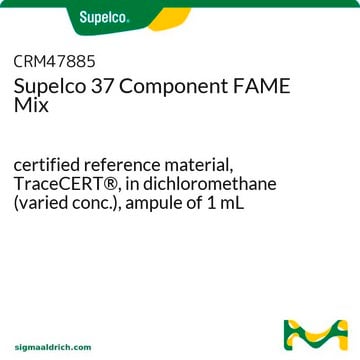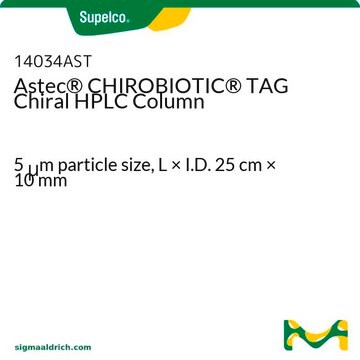53023AST
Astec® CLC-D Chiral (5 μm) HPLC Columns
L × I.D. 15 cm × 4.6 mm, HPLC Column
Sinônimo(s):
Chiral Separation CLC-D Column
Faça loginpara ver os preços organizacionais e de contrato
About This Item
Código UNSPSC:
41115700
eCl@ss:
32110501
NACRES:
SB.52
Produtos recomendados
Nome do produto
Astec® CLC-D Chiral HPLC Column, 5 μm particle size, L × I.D. 15 cm × 4.6 mm
Materiais
stainless steel column
Nível de qualidade
Agency
suitable for USP L32
linha de produto
Astec®
embalagem
pkg of 1 ea
fabricante/nome comercial
Astec®
Parâmetros
0-50 °C temperature
172 bar pressure (2500 psi)
técnica(s)
HPLC: suitable
C × D.I.
15 cm × 4.6 mm
Matriz
fully porous particle
Grupo ativo da matriz
chiral bidentate ligand (D-form), requires 5 mM CuSO4 phase
tamanho de partícula
5 μm
tamanho de poro
100 Å
pH operacional
3.5-7
técnica de separação
chiral
Descrição geral
CLC columns use the copper ligand concept described by Davankov to effect enantiomer separation (1). The method uses a small, chiral bidentate ligand attached to the silica surface and a copper sulphate-containing mobile phase. The copper ions coordinate with the chiral selector on the stationary phase and carboxylic acid functional groups on the analytes to form transient diastereomeric complexes in solution. The technique also has the advantage of giving small acids with no UV chromophore a strong 254 nm signal. CLC columns are ideal for analysis of hydroxy acids, like lactic, malic, tartaric and mandelic acids, amino acids, other amines and bi-functional racemates, like amino alcohols. Proline and aspartic acid are particularly suited for low-level detection on the CLC column since the copper complex is detected at 254 nm UV. Both can be resolved on the CLC-D or CLC-L in 5 mM CuSO4 with the usual reversal of elution order from the CLC-D to CLC-L. In theory, any analyte that can complete the coordination with the copper ion can be resolved. Two versions of the column provide elution order reversal. On the CLC-D column, the L enantiomer generally elutes before D, with the exception of tartaric acid. The reverse is true on the CLC-L column where D elutes before L.
Features:
(1) Davankov, V. A.; Rogozhin, S. V. Ligand chromatography as a novel method for the investigation of mixed complexes: Stereoselective effects in a-amino acid copper(II) complexes. J. Chrom. A. 1971, 60, 284-312.
Features:
- Separates α-hydroxy carboxylic acids, amino acids and other α-bifunctional compounds
- High selectivity with simple mobile phases
- Copper complex gives strong UV 254 nm signal
- Simple reversal of elution order, CLC-L vs. CLC-D
- Excellent reproducibility
(1) Davankov, V. A.; Rogozhin, S. V. Ligand chromatography as a novel method for the investigation of mixed complexes: Stereoselective effects in a-amino acid copper(II) complexes. J. Chrom. A. 1971, 60, 284-312.
Informações legais
Astec is a registered trademark of Merck KGaA, Darmstadt, Germany
Escolha uma das versões mais recentes:
Já possui este produto?
Encontre a documentação dos produtos que você adquiriu recentemente na biblioteca de documentos.
Enantiomeric impurities in chiral catalysts, auxiliaries, synthons and resolving agents. Part 2
Armstrong, Daniel W., et al.
Tetrahedron Asymmetry, 10 (1), 37-60 (1999)
Badal C Saha et al.
Biotechnology and bioengineering, 82(7), 864-871 (2003-04-18)
Lactobacillus intermedius B-3693 was selected as a good producer of mannitol from fructose after screening 72 bacterial strains. The bacterium produced mannitol, lactic acid, and acetic acid from fructose in pH-controlled batch fermentation. Typical yields of mannitol, lactic acid, and
Chromatograms
application for HPLCapplication for HPLCNossa equipe de cientistas tem experiência em todas as áreas de pesquisa, incluindo Life Sciences, ciência de materiais, síntese química, cromatografia, química analítica e muitas outras.
Entre em contato com a assistência técnica






